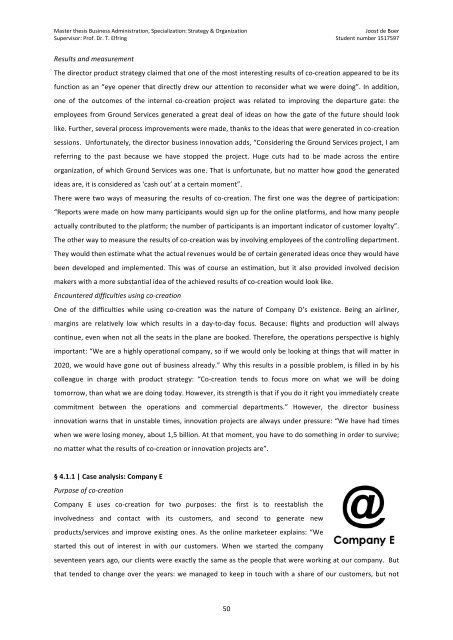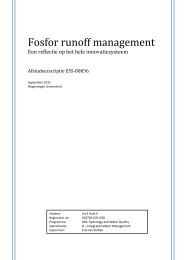Download PDF (English) - Future Ideas
Download PDF (English) - Future Ideas
Download PDF (English) - Future Ideas
Create successful ePaper yourself
Turn your PDF publications into a flip-book with our unique Google optimized e-Paper software.
Master thesis Business Administration, Specialization: Strategy & Organization <br />
Supervisor: Prof. Dr. T. Elfring <br />
Joost de Boer <br />
Student number 1517597 <br />
Results and measurement <br />
The director product strategy claimed that one of the most interesting results of co-‐creation appeared to be its <br />
function as an “eye opener that directly drew our attention to reconsider what we were doing”. In addition, <br />
one of the outcomes of the internal co-‐creation project was related to improving the departure gate: the <br />
employees from Ground Services generated a great deal of ideas on how the gate of the future should look <br />
like. Further, several process improvements were made, thanks to the ideas that were generated in co-‐creation <br />
sessions. Unfortunately, the director business innovation adds, “Considering the Ground Services project, I am <br />
referring to the past because we have stopped the project. Huge cuts had to be made across the entire <br />
organization, of which Ground Services was one. That is unfortunate, but no matter how good the generated <br />
ideas are, it is considered as ‘cash out’ at a certain moment”. <br />
There were two ways of measuring the results of co-‐creation. The first one was the degree of participation: <br />
“Reports were made on how many participants would sign up for the online platforms, and how many people <br />
actually contributed to the platform; the number of participants is an important indicator of customer loyalty”. <br />
The other way to measure the results of co-‐creation was by involving employees of the controlling department. <br />
They would then estimate what the actual revenues would be of certain generated ideas once they would have <br />
been developed and implemented. This was of course an estimation, but it also provided involved decision <br />
makers with a more substantial idea of the achieved results of co-‐creation would look like. <br />
Encountered difficulties using co-‐creation <br />
One of the difficulties while using co-‐creation was the nature of Company D’s existence. Being an airliner, <br />
margins are relatively low which results in a day-‐to-‐day focus. Because: flights and production will always <br />
continue, even when not all the seats in the plane are booked. Therefore, the operations perspective is highly <br />
important: “We are a highly operational company, so if we would only be looking at things that will matter in <br />
2020, we would have gone out of business already.” Why this results in a possible problem, is filled in by his <br />
colleague in charge with product strategy: “Co-‐creation tends to focus more on what we will be doing <br />
tomorrow, than what we are doing today. However, its strength is that if you do it right you immediately create <br />
commitment between the operations and commercial departments.” However, the director business <br />
innovation warns that in unstable times, innovation projects are always under pressure: “We have had times <br />
when we were losing money, about 1,5 billion. At that moment, you have to do something in order to survive; <br />
no matter what the results of co-‐creation or innovation projects are”. <br />
§ 4.1.1 | Case analysis: Company E <br />
Purpose of co-‐creation <br />
Company E uses co-‐creation for two purposes: the first is to reestablish the <br />
involvedness and contact with its customers, and second to generate new <br />
products/services and improve existing ones. As the online marketeer explains: “We <br />
started this out of interest in with our customers. When we started the company <br />
seventeen years ago, our clients were exactly the same as the people that were working at our company. But <br />
that tended to change over the years: we managed to keep in touch with a share of our customers, but not <br />
50





